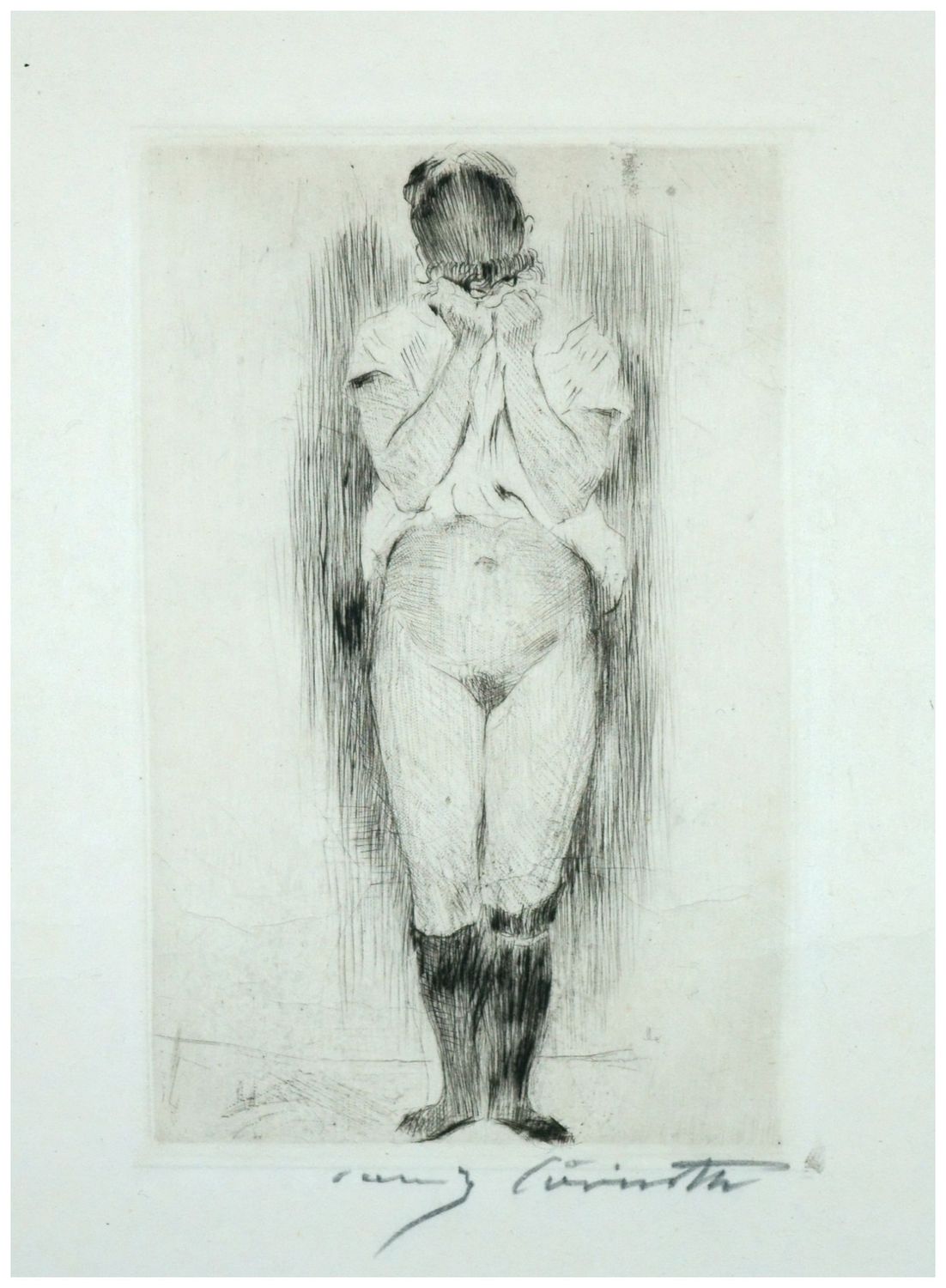Corinth, Lovis (1858-1925), Weeping Girl, 1899
Lovis Corinth(1858 Tapiau - 1925 Zandvoort), Weeping Girl , 1899 (Schwarz 20). Drypoint etching signed by hand in pencil on strong Japan. 15 x 10 cm (plate), 35 x 27 cm (sheet), dry stamp of Bruno Cassirer Verlag (L. 3638) at lower left.
- Strong and precise impression. Minimal paper squeeze in the lower third of the image. The broad margin outside the image darkened, at the back side shadow of an old mounting.
Exposé as
PDF
- Hidden and exposed at the same time -
The relatively small format and the only implied space, which is completely covered by the figure, create an intimate setting in which a weeping girl is depicted. In order to be completely alone in her grief, she hides her face with her dress. At the same time, however, this stretching is an uncovering, since, by lifting her dress, she stands naked without realising it. It is therefore a double intimacy, ambivalent towards each other: We are present at the mourning, which wants to remain alone for itself, and at the same time we become aware of the unconsciously exposed body, which counteracts the empathy with the mourning.
This ambivalence between grief and eros creates a tension in the painting that is all the more effective because it is not artificially evoked, as it would have been if Corinth had followed the tradition of academic nude painting. In Paris, he had studied nude painting intensively at the private Académie Julian. With the etching 'Weeping Girl', the result is in sight: a new nude that is not artificial but authentic, or, to put it another way, not traditionally academic but naturalistic. This includes the fact that the body is not polished to a high gloss and does not correspond to any textbook ideal of beauty, but seems to have been taken from everyday life.
The authenticity of the body is where Corinth's mastery of the etching needle comes to the fore: the girl's body stands out against a vertically hatched dark background, its haptic fleshiness created by delicate, virtuously applied layers of strokes. The layers of strokes are both a means of representation and, as in the case of the taut strands of hair, the subject of the picture.
About the artist

Determined to become an artist, Corinth entered the Königsberg Art Academy in 1876, where he studied under Otto Günther, who introduced him to Weimar plein-air painting. On Günther's recommendation, Corinth moved to the Munich Art Academy in 1880. There, under the influence of the circle of Leibl and Wilhelm Trübner, he adopted a naturalistic approach to art that was opposed to academic history painting.
After interrupting his studies for a year to do voluntary military service, Corinth went on a study trip to Italy in 1883 and the following year to Antwerp, where he took art lessons from Paul Eugène Gorge. From 1884 to 1887, Corinth stayed in Paris and devoted himself mainly to nude painting at the private Académie Julian.
After a stopover in Berlin, where he met Max Klinger, Walter Leistikow and Karl Stauffer-Bern, Corinth lived in Munich from 1891 to 1901 and became a founding member of the Munich Secession, which was founded in 1892 by Max Liebermann, Otto Eckmann, Thomas Theodor Heine, Hans Olde, Hans Thoma, Wilhelm Trübner, Franz von Stuck and Fritz von Uhde. The Secession gave rise to the Free Association of the XXIV or Munich 24, to which Corinth also belonged.
In 1894, under the tutelage of Otto Eckmann, Corinth learnt the art of etching and, in the field of painting, developed the wet-on-wet style that would characterise his work and lead to the relief-like texture of his paintings.
His relationship with Berlin became more and more intense. When he attended the first exhibition of the Berlin Secession in 1899, he painted a portrait of Liebemann, who in turn painted a portrait of Corinth. After the Munich Secession rejected his painting Salome, he finally moved to Berlin, where the painting was admired at the Secession exhibition and Corinth - through Leistikow - became a much sought-after portraitist.
In 1903 Corinth opened an art school and in 1904 he married his first pupil, Charlotte Berend. His first solo exhibition was organised by Paul Cassirer. In Berlin, Corinth also began to devote himself to the theatre. He worked with Max Reinhardt, designing sets and costumes.
Following Max Liebermann's resignation, Corinth was elected chairman of the Secession in 1911. In the same year, he suffered a stroke that paralysed half of his body. He then devoted himself intensively to graphic art and opened up the field of book illustration.
In 1913, Paul Cassirer organised the first major retrospective of Corinth's work, and in 1918, on his 60th birthday, the Berlin Secession devoted a major exhibition to his work. In 1923, on his 65th birthday, his artistic career was crowned with a extense solo exhibition at the National Gallery.
Even after the 'Freie Sezession' split from the 'Berliner Sezession', Corinth remained in the original association, becoming chairman again in 1915 and professor at the Berlin Academy of Arts the following year.
In 1919, the Corinths purchased the retreat at the Walchensee in Bavaria, which Corinth captured in more than 60 paintings. Corinth died in 1925 on a trip to Amsterdam to see his great idols, Frans Hals and Rembrandt.
Selected Bibliography
Heinrich Müller: Die späte Graphik von Lovis Corinth, Hamburg 1960.
Thomas Deecke: Die Zeichnungen von Lovis Corinth. Studien zur Stilentwicklung, Berlin 1973.
Zdenek Felix (Hrsg.): Lovis Corinth. 1858–1925, Köln 1985.
Karl Schwarz: Das Graphische Werk von / The Graphic Work of Lovis Corinth, San Francisco 1985.
Horst Uhr: Lovis Corinth, Berkeley 1990.
Charlotte Berend-Corinth: Lovis Corinth: Die Gemälde. Neu bearbeitet von Béatrice Hernad, München 1992.
Peter-Klaus Schuster / Christoph Vitali / Barbara Butts (Hrsg.): Lovis Corinth, München 1996.
Michael F. Zimmermann: Lovis Corinth, München 2008.

